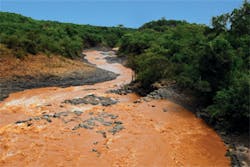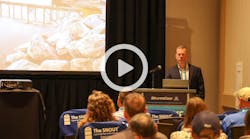Mats, Concrete, Blocks, and Rocks: The Lowdown on Riprap – Part 3
Idaho’s Rural Use of Riprap
In rural areas, including parts of Idaho, rock materials are readily available from quarries, farms, and construction sites. In the changing landscape of the rural and urban interface, used concrete continually is being torn out and recycled in landscapes. Rock is used, often with willow and cattail plantings, to stabilize streambanks and create wildlife habitat ponds.
As part of the Middle Snake River Nutrient Management Plan in Twin Falls, ID, the University of Idaho and Agricultural Research Service (ARS) teamed up with the Twin Falls and North Side Canal Companies to reduce erosion sediment inflow into the Snake River. As part of a five-year plan, the Twin Falls Canal Company identified several areas that were severely eroding.
The two major drains identified for stabilization were the LQ and LS drains. Both of these drains are major return flow streams to the Snake River. Between the two, they return flows from over 7,000 irrigated ac. in the Magic Valley area back to the Snake River. Moderate-to-steep slopes on highly erosive silt loam soils characterize the drainage areas for these two streams.
The two drains have a long history of being major contributors to sediment and phosphorus in the river. The LQ drain alone deposited 9,300 tons of sediment to the Snake in 1977, according to a study by the University of Idaho and ARS. The study also determined that the LS drain discharged 12,000 tons of sediment during the irrigation season in 1980. Although a project in the 1980s to reduce the load by on-farm and large pond systems was successful, the practices quickly were abandoned after the end of the official project. The result was the return to preproject levels of sediment being deposited to the Snake River. By the 1995 irrigation season, some 9,250 tons of sediment were being returned to the river.
“Right now that number is probably about half,” states Brian Olmstead, Twin Falls Canal Company manager. “We’ve already removed a lot of that.”
A pond, known as Brennan pond, was dug about four years ago as part of the overall project. Now a mature pond, it presents large cattail, willows, and other native grasses along the shores. The tons of riprap used to stabilize the edges are only slightly visible. The overflow area, made up of various sizes of rocks, is intact and provides a smooth transition for water to spill over to the lower land area.
The Malone pond project on the lower, overflow land is a 17-acre project that includes an 8-acre sediment-settling pond. As part of building and reinforcing the pond, Olmstead says approximately 300 tons of riprap will be layered this year.
“In the overflow area we use alternating layers of rock and gravel,” he says, describing the rocky spillways. “It also keeps the rodents and small animals out. But we’ve never had a rock overflow fail.”
After the addition of biological plantings and some time, the Malone pond will mature into wildlife habitat for waterfowl. Olmstead says that up the Snake River Canyon another 10 miles or so, in a place known as Pigeon Cove, the plan is to restore a former commercial fishpond for sport fishing.
Although the Brennan and Malone ponds use riprap in conjunction with biological remediation, there are times when it is necessary to use riprap alone. Olmstead refers to the Milner Dam in Murtaugh, ID. The dam, built in the early 1900s and rebuilt in 1992, must be inspected and renewed each year by the Federal Energy Regulatory Commission and the Canal Company.
“Milner Dam is a good example of an earth-filled dam,” notes Olmstead. “And out there you wouldn’t want to have anything biological with roots growing in because each year we have to draw the water down to inspect it.”
The Trend Toward “Soft” Techniques
Although there are a few examples of times when hard armor is used exclusively, such as the dam or in some urban flood remediation projects in the Southwest, many researchers maintain that “softer” is better. The Idaho Fish and Game natural resource biologist, Chuck Warren, defers to a study and literature review by David A. Schmetterling, Christopher G. Clancy, and Troy M. Brandt of Montana Fish, Wildlife, and Parks. Brandt is a fisheries biologist for Water Consulting in Hamilton, MT. The study examined the effects of riprap on stream salmonids in the Western US.
The authors are adamant in their belief that riprapping streambanks is responsible for fish habitat loss and degradation. They point to woody vegetation and dense root systems as a more viable means for sustaining bank integrity. By increasing bank roughness, they say, the stream energy is dissipated during peak flows. An alternative to hard armor in low-gradient streams might be using sod mats, while higher-gradient streams are dependent upon the woody vegetation and root systems.
In essence, the use of more natural material, such as trees and rootwads, provides a good alternative and is proving to be of greater benefit to the ecosystem than rock riprap is. Streams, being the dynamic and living systems that they are, need a continual sloughing of organic matter to keep them healthy and alive. The “soft” techniques, as they are referred to, aim to slow the erosion rather than stop it completely. These techniques are, however, not as researched and proven as riprap and therefore are more risky to landowners. To some degree they might be more labor-intensive and expensive and take longer to provide the stabilization protection desired.
Whether to use riprap alone, to use it with vegetation, or to use only soft techniques might depend entirely upon where it’s being used and its intended use in the future. The study does acknowledge that there are times that large, angular rocks were introduced on severely degraded rivers and habitat quality was seen to improve because “large substrates can allow for fish utilization of interstices.” Additionally, the fish specialists stress that the impacts of riprap on stream geomorphology, riparian conditions, and large, woody debris are areas that need more assessment and study.
One of the most important conclusions of the study is that property developers should be discouraged from using floodplain properties and that development of management plans that incorporate the “unpredictability of rivers and streams is essential where development already exists.”
In conclusion, the three summed up the entire dilemma by saying, “Resource managers will continue to struggle with the paradox of allowing natural fluvial processes and protecting private property and public infrastructure from those same processes.”


